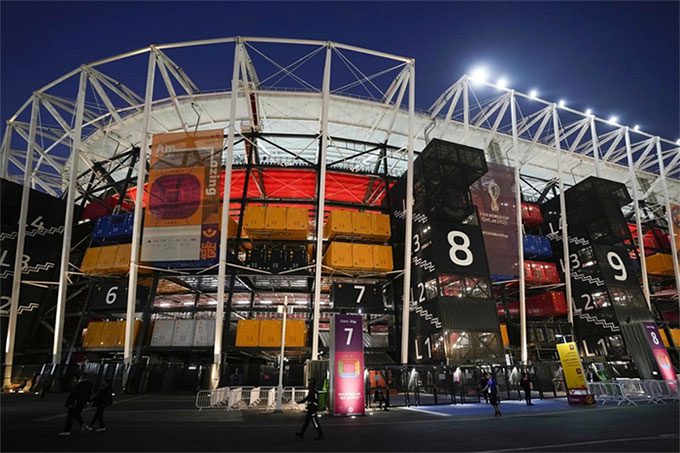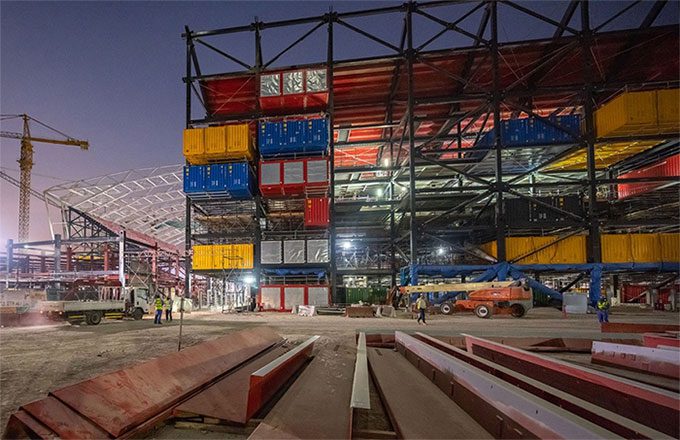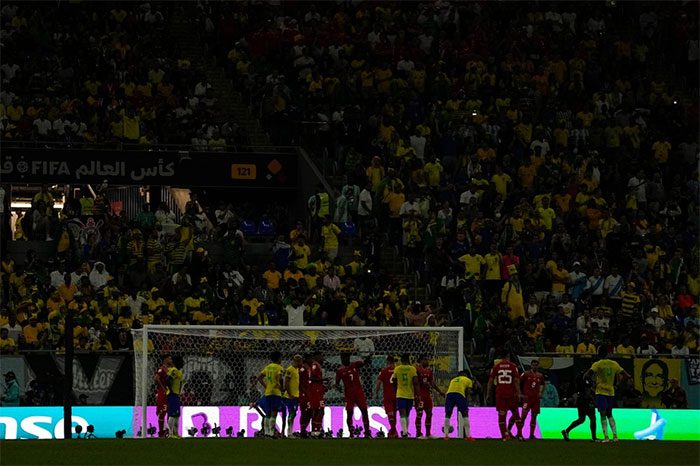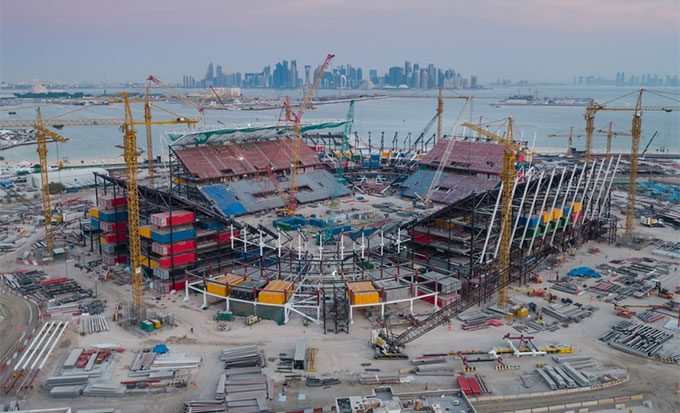Experts praise the design process of Stadium 974, which has a capacity of 40,000 seats and is constructed from 974 recycled shipping containers in Doha. This stadium will be dismantled after the Round of 16 in the World Cup.
Among the seven stadiums built by host nation Qatar for the 2022 World Cup, one stadium will disappear following Brazil’s victory over South Korea in the Round of 16.
This is what the tournament organizers say about Stadium 974, built from 974 recycled containers in Doha. The number 974 is also the international dialing code for Qatar.

Stadium 974, with a capacity of 40,000 seats, constructed from 974 recycled containers in Doha. (Photo: AP).
The Qatari officials stated that Stadium 974 will disappear, but it is unclear when this will occur. After being dismantled, it could be transported to countries in need of such infrastructure. Experts worldwide commend this modern design but also emphasize the importance of what happens to Stadium 974 after the World Cup concludes.
Built for Disassembly
“A modular design is one of the key principles of a sustainable building,” said Karim Elgendy, a contributor at the London-based Chatham House consulting group and a former climate advisor for the World Cup.
Elgendy added: “It allows for the natural restructuring of a construction site or repurposing it for another function. However, we still need to observe several factors before we can call a building sustainable.”
According to AP, buildings account for nearly 40% of global energy-related carbon emissions. Of this, about 10% comes from carbon or greenhouse gas emissions related to the construction, maintenance, and demolition of buildings.

The modular design of Stadium 974. (Photo: Fenwick Iribarren Architects).
This is the first stadium in the world with a fully removable roof. Subsequently, Stadium 974 will be transported and reassembled in Maldonado, Uruguay, for the 2030 World Cup if the South American nation secures hosting rights.
The number 974 is the international code for the host country of the 2022 World Cup and also the number of shipping containers used in the construction of this venue. “Sustainability” and “boldness” are the messages Qatar aims to convey through this grand stadium.
Additionally, it is also the only stadium in the 2022 World Cup that does not require an artificial cooling system. Therefore, matches here are often scheduled for later times. During the final group match between Switzerland and Serbia, the atmosphere at Stadium 974 was significantly more humid and hot compared to other venues.
Moreover, due to the lack of modern equipment, Stadium 974 also experienced a rare incident during the second match of Group G between Brazil and Switzerland.
<pSpecifically, in the 45th minute, as Brazil was preparing to take a corner kick, the lighting system at Stadium 974 suddenly malfunctioned. The field was plunged into darkness, causing a disruption in the match for about 8 seconds.

The lighting system at Stadium 974 suddenly malfunctioned. (Photo: AP).
Fenwick Iribarren Architects, the design firm behind Stadium 974 and two other World Cup stadiums, stated that the idea aims to avoid building “white elephants.”
This slang refers to a stadium that is not used or is underutilized after a tournament ends, a situation that has occurred in previous World Cup host nations such as South Africa, Brazil, and Russia.
The Challenge of Reducing Emissions
Like giant Lego blocks, the brightly colored, wavy steel boxes in red, yellow, and green appear suspended between layers of steel outside Stadium 974. This design gives the stadium a very modern feel.
After being dismantled, where the components of Stadium 974 will go is equally important due to the emissions involved in transporting them, especially if they are moved thousands of kilometers away.

Brightly colored wavy steel boxes appear suspended between layers of steel outside Stadium 974. (Photo: Fenwick Iribarren Architects).
Carbon Market Watch, an environmental monitoring group responsible for sustainable plans for the World Cup in Qatar, stated that the carbon emissions from Stadium 974 are lower than a fixed stadium, depending on “the number of times and the distance it is transported and reassembled.”
Both FIFA and Qatar acknowledged this in a report estimating the emissions of Stadium 974. If reused only once, they estimate that the emissions from Stadium 974 will be lower than that of a fixed stadium as long as it is transported less than 7,000 kilometers.
If reused multiple times, Stadium 974 could be transported farther. However, FIFA’s report still asserts that this would be less polluting than a fixed venue due to the costs associated with building multiple new stadiums.

The construction and dismantling process of Stadium 974. (Photo: Fenwick Iribarren Architects).
The report also does not account for emissions when bringing Stadium 974 into operation or emissions generated from operating a building. The reason given is due to differing standards in many countries, FIFA and Qatar stated.
“The energy required to dismantle and transport the parts of the building will clearly need to be estimated. However, it is unlikely to exceed the carbon emissions from conventional building materials,” Elgendy commented.




















































